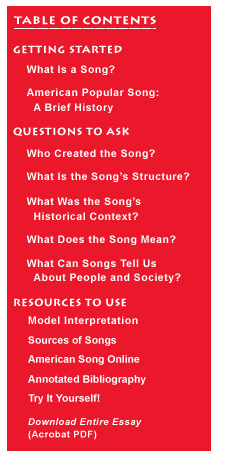talking history | syllabi | students | teachers | puzzle | about us

|
 |
|
Austin, William W. “Susanna,” “Jeanie,”
and “The Old Folks at Home”: The Songs of Stephen C. Foster
from His Time to Ours. New York: Macmillan, 1975. Popular Music and Society. Published by the Sociology Department
of Bowling Green State University. Began in 1971. Cockrell, Dale. Demons of Disorder: Early Blackface Minstrels and
Their World. Cambridge: Cambridge University Press, 1997. Crawford, Richard. America’s Musical Life: A History. New
York and London: W.W. Norton & Company, 2001. Forte, Allen. The American Popular Ballad of the Golden Era, 1924-1950.
Princeton: Princeton University Press, 1995. Fuld, James J. The Book of World-Famous Music: Classical, Popular
and Folk. Foreward by William Lichtenwanger. New York: Crown Publishers:
1966. Grove Dictionary of American Music. Restricted database available
online at through some schools and colleges. Hamm, Charles. Yesterdays: Popular Song in America. New York
and London: W.W. Norton & Company, 1983. Krummel, Donald William. Bibliographic Handbook of American Music.
Urbana: University of Illinois Press, 1987. Lawrence, Vera Brodsky. Strong on Music: The New York Music Scene
in the Days of George Templeton Strong. 3 vols. Chicago: University
of Chicago Press, 1987-1999. Levine, Lawrence W. Highbrow/Lowbrow: The Emergence of Cultural Hierarchy
in America. Cambridge and London: Harvard University Press, 1988. Music of the United States of America. Middleton, WI: A-R Editions,
1993-. Nathan, Hans. Dan Emmett and the Rise of Early Negro Minstrelsy.
Norman: University of Oklahoma Press, 1962. Nevins, Allan, ed. The Diary of Philip Hone, 1828-1851. New
York: Krause Reprint, 1969. Nineteenth-Century American Musical Theater. New York: Garland,
1994. Peterson, Richard A. Creating Country Music: Fabricating Authenticity.
Chicago and London: University of Chicago Press, 1997. Riis, Thomas Laurence. Just before Jazz: Black Musical Theater in
New York, 1890-1915. Washington: Smithsonian Institution Press, 1989. Southern, Eileen. The Music of Black Americans: A History. New
York: Norton, 1983. 2nd ed. Toll, Robert. Blacking Up: The Minstrel Show in Nineteenth-Century
America. New York: Oxford University Press, 1974. Wilder, Alec and James T. Maher. American Popular Song: The Great
Innovators, 1900-1950. New York: Oxford University Press, 1990. |
|

|
|
